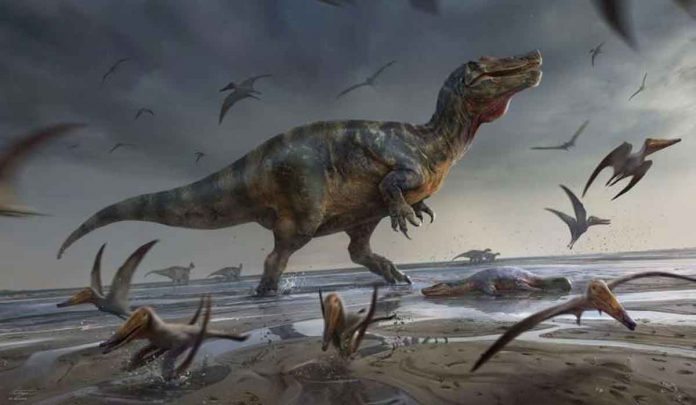Paleontologists at the University of Southampton have discovered the remains of one of Europe’s largest land-based hunts, a 10m-long dinosaur that lived some 125 million years ago. Several prehistoric bones discovered on the Isle of Wight, on England’s south coast, and housed at the Dinosaur Isle Museum in Sandown belonged to spinosaurids, a type of two-legged, crocodile-faced carnivorous dinosaur. It was known as the ‘White Rock spinosaurid,’ after the geological strata in which it was discovered. It was a massive predator.
“This was a massive beast, measuring more than 10 meters in length and weighing many tonnes. According to some of the proportions, it appears to be one of the largest carnivorous dinosaurs ever discovered in Europe, if not the largest “Chris Barker, a Ph.D. student who conducted the investigation, remarked, “It’s a shame we just have a tiny bit of information, but it’s enough to prove it was a massive beast.”
The discovery follows prior research on spinosaurids by a team from the University of Southampton, which published a publication in 2021 detailing the discovery of two new species.
The ‘White Rock spinosaurid’ bones were discovered in Compton Chine, on the Isle of Wight’s southwest coast, and comprise massive pelvis and tail vertebrae, among other fragments. The Cretaceous rocks are famed for its dinosaurs, but it’s less well recognized that the Island’s fossil record preserves dinosaurs from other periods of history, some of which are still poorly understood today.
“This species eroded out of the Vectis Formation, which is famously low in dinosaur fossils,” stated corresponding author Dr. Neil Gostling of the University of Southampton, who teaches evolution and palaeobiology. “It’s most certainly the youngest spinosaur material ever discovered in the UK.”
The Vectis Formation, which dates back 125 million years, represents the beginning of a time of rising sea levels, when the “White Rock spinosaurid” hunted for food in lagoonal waters and sandflats.
“We haven’t given it a proper scientific name because it’s just known from fragments at the moment,” said co-author Darren Naish. “We hope that further remains will turn up in time,” he continued.
“This new animal supports our prior argument, which was published last year, that spinosaurid dinosaurs originated and developed in Western Europe before spreading throughout the rest of the world.”
Marks on the bone also revealed that the body of this mammoth undoubtedly supported a variety of scavengers and decomposers even after death.
“Nick Chase, one of Britain’s most accomplished dinosaur hunters, regrettably died right before the COVID epidemic,” said co-author Jeremy Lockwood, a Ph.D. student at the University of Portsmouth and Natural History Museum. “I was looking for dinosaur remains with Nick and came across a lump of pelvis with tunnels carved into it the size of my index finger. They were most likely caused by bone-eating larvae of a scavenging beetle. It’s an intriguing concept that this colossal killer ended up as a food for a variety of insects.”
In the near future, the researchers intend to produce thin sections of the material to examine the tiny internal features of the bones, which could reveal information on its growth rate and age.
The study was published in the peer-reviewed journal PeerJ.

